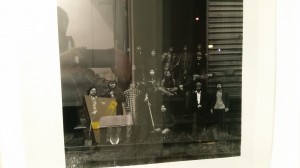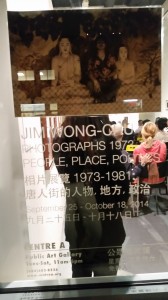A special exhibition by Jim Wong Chu chronicling some of the historical events around Chinatown has been held at Centre A, Vancouver International Centre for Contemporary Asian Art. As second and third generation Asian Canadians, the people in the old photographs were witnesses to the social and cultural development in Vancouver and in Chinatown. Featured in the exhibit were photos of social activism such as the Quebec-Columbia Connector Freeway protests, drive to save Chinese BBQ, and other snippets of life around Chinatown and its inhabitants. The pictures, mostly action shots of people in daily activities, assert a communal voice that becomes the narrator in a communal life narrative.
The power of pictures aside, however, I want to turn my attention to the effects of using photographs to tell a life narrative in comparison to using words. One of the most ironic aspects of a photo exhibit is that while every single shot is taken by the photographer and is, in some way, a reflection and expression of the photographer’s life, the photographer is always absent. In class, we discussed at length about the factors that affect the authenticity or “truthfulness” of a life narrative, and one of the factors we focused on was whose voices are expressed, why and to what effect. In the case of Fred Wah, hearing his own words about himself greatly helped to solidify his character; meanwhile, in Sarah DeVries’ case, her person was communicated through the voices of others as well as her own words. Telling a story through photography, on the other hand, has a different complexity. While the photographer can choose the subjects and episodes for her/his shot, the message is completely out of her/his control. The subtle facial expressions and body gestures spontaneously captured in a photograph may contain elements of truth that can never be verbalized, and even betray the intentions of the photographer. Despite having full control over the setting, and thereby always being able to set the context, the photographer can never be the subject of her/his photo narrative. This is in contrast to telling story with words in which the writer can clearly express her/his opinions, but often has limited control over the context and how the messages are received.
Today’s exhibit featured photos of Vancouver’s Chinatown in the 1970’s, highlighted by social activism and cultural imprints. While Jim, the photographer, is not in any of the photos that he took, he still tells his life narrative through the reflections of people he photographed. A single authoritative voice that writers often look for in a written story may not be present in Jim’s photographs, but by withdrawing that authoritative “I”, Jim’s life narrative becomes naturally placed with the community narrative, and becomes part of communal history.

A group of Chinese Canadians pose in a boxcar as an homage to the complex history between the CPR and the Chinese community. Sean (middle with a shovel) says, “We just got together to take that photo. It was sometime in the 70’s. We told Jim to set the timer, but he wanted to just take the picture.”
